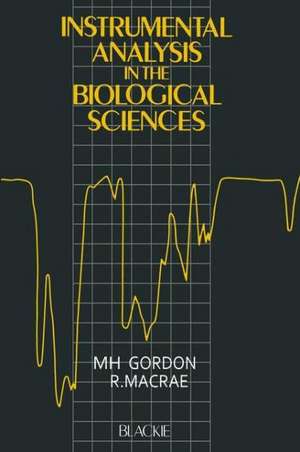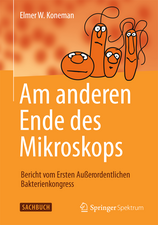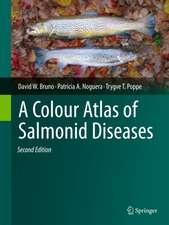Instrumental Analysis in the Biological Sciences
Autor M. H. Gordonen Limba Engleză Paperback – 1989
Preț: 363.83 lei
Nou
Puncte Express: 546
Preț estimativ în valută:
69.63€ • 72.25$ • 58.20£
69.63€ • 72.25$ • 58.20£
Carte tipărită la comandă
Livrare economică 13-19 martie
Preluare comenzi: 021 569.72.76
Specificații
ISBN-13: 9780216920101
ISBN-10: 0216920108
Pagini: 244
Ilustrații: XII, 244 p. 19 illus.
Dimensiuni: 152 x 229 x 14 mm
Greutate: 0.35 kg
Ediția:1987
Editura: Springer Us
Colecția Springer
Locul publicării:New York, NY, United States
ISBN-10: 0216920108
Pagini: 244
Ilustrații: XII, 244 p. 19 illus.
Dimensiuni: 152 x 229 x 14 mm
Greutate: 0.35 kg
Ediția:1987
Editura: Springer Us
Colecția Springer
Locul publicării:New York, NY, United States
Public țintă
ResearchCuprins
1 Introduction to instrumental methods of analysis.- 1.1 Precision and accuracy.- 1.2 Speed of analysis.- 1.3 Cost.- 1.4 Safety.- 1.5 Automation.- Recommended general texts.- 2 Liquid chromatography.- 2.1 Introduction.- 2.2 Theory of liquid chromatography.- 2.3 Modes of chromatography.- 2.4 Chromatographic techniques.- 2.5 Sample preparation.- References.- 3 Gas chromatography.- 3.1 Introduction.- 3.2 Principles.- 3.3 The chromatographic system.- 3.4 GLC columns.- 3.5 Principles of separation.- 3.6 Stationary phases.- 3.7 Gas—solid chromatography.- 3.8 Detectors.- 3.9 Sample preparation.- 3.10 Quantification.- References.- 4 Electrophoresis.- 4.1 Introduction.- 4.2 Effect of pH on charge.- 4.3 Techniques of electrophoresis.- 4.4 Isotachophoresis.- References.- 5 Introduction to spectroscopy.- 5.1 Spectroscopy.- 5.2 The electromagnetic spectrum.- 5.3 Molecular energy states.- 5.4 Molecular transitions.- 5.5 Quantitative analysis.- 5.6 Determination of a spectrum.- Further reading.- 6 UV—visible spectrophotometry.- 6.1 Introduction.- 6.2 Electronic energy levels.- 6.3 Electronic transitions.- 6.4 Qualitative analysis.- 6.5 Quantitative analysis.- 6.6 Calibration of spectrophotometers.- 6.7 Sample presentation.- 6.8 Difference spectrophotometry.- 6.9 Spectrophotometric titrations.- 6.10 Derivative spectrophotometry.- 6.11 Dual-wavelength spectrophotometry.- 6.12 Spectrophotometers and colorimeters.- 6.13 Turbidimetry and nephelometry.- 6.14 Colour and gloss of solid samples.- References.- 7 Fluorescence and phosphorescence spectrophotometry.- 7.1 Introduction.- 7.2 Fluorophores.- 7.3 Excitation and emission spectra.- 7.4 Quantitative measurements.- 7.5 Factors affecting fluorescence spectra.- 7.6 Instruments for fluorescence studies.- 7.7 Applications of fluorescencespectrophotometry.- References.- 8 Infrared spectroscopy.- 8.1 Introduction.- 8.2 Molecular vibrations.- 8.3 Qualitative analysis.- 8.4 Quantitative analysis.- 8.5 Instrumentation.- 8.7 Attenuated total reflectance.- 8.8 Near-infrared reflectance analysis.- References.- 9 Nuclear magnetic resonance spectroscopy.- 9.1 Introduction.- 9.2 Principles.- 9.3 Pulse NMR spectrometer.- 9.4 Chemical shifts.- 9.5 Spin—spin coupling.- 9.6 Integration.- 9.7 Further techniques for elucidation of NMR spectra.- 9.8 Wide-line NMR.- 9.9 In-vivo NMR.- References.- 10 Electron spin resonance.- 10.1 Principles.- 10.2 ESR spectra.- 10.3 ESR spectrometer.- 10.4 Sample preparation.- 10.5 Spin labelling.- 10.6 Quantitative analysis.- References.- 11 Flame techniques.- 11.1 Introduction.- 11.2 Flame emission spectrometry (FES).- 11.3 Atomic absorption spectrometry (AAS).- 11.4 Applications.- References.- 12 Mass spectrometry.- 12.1 Introduction.- 12.2 Mass spectrometer.- 12.3 Analysis of mixtures.- 12.4 Determination of molecular structures.- References.- 13 Electrochemical techniques.- 13.1 Introduction.- 13.2 Conductivity of solutions.- 13.3 Voltammetry.- 13.4 Potentiometric measurements.- References.










